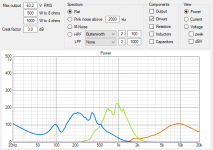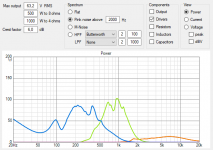Hi guys!
I have some questions.
How to properly set up a DSP limiter time constants (attack and release times) for RMS limiting for a 3 way passive speaker with a passive crossover network?
In tri-amp configuration with active crossover, setting up the limiter for each band isn't so difficult because there are some empirical methods for tuning attack and release times as a function of voice coils sizes. But with passive crossover isn't so trivial because all bands comes from one amplifier channel. So the goal is protecting the 3 way passive system from thermal damage with minimal audible limiter artifiacts.
The setup is:
I know the power distribution between the drives, simulated with continuous flat response signal and pink noise cf. 6dB. (Attached images)
The second question is the DSP has attack times from 0.3 ms up to 100 ms and release times from 2x to 32x the attack time. But these time constants seem more like peak limiting settings. Is this usable for RMS limiting in this configuration?
Thank you all for your replies!
I have some questions.
How to properly set up a DSP limiter time constants (attack and release times) for RMS limiting for a 3 way passive speaker with a passive crossover network?
In tri-amp configuration with active crossover, setting up the limiter for each band isn't so difficult because there are some empirical methods for tuning attack and release times as a function of voice coils sizes. But with passive crossover isn't so trivial because all bands comes from one amplifier channel. So the goal is protecting the 3 way passive system from thermal damage with minimal audible limiter artifiacts.
The setup is:
- 2 x 10" midbass, 2.5" voice coil, 250W RMS/driver
- 1 x 8" mid, 2.5" voice coil, 250W RMS
- 2 x compression drivers, 3" voice coil, 110W RMS/driver
- The passive crossover does not contain protection.
- The systems high pass frequency is 100Hz.
I know the power distribution between the drives, simulated with continuous flat response signal and pink noise cf. 6dB. (Attached images)
The second question is the DSP has attack times from 0.3 ms up to 100 ms and release times from 2x to 32x the attack time. But these time constants seem more like peak limiting settings. Is this usable for RMS limiting in this configuration?
Thank you all for your replies!
Attachments
Peak limiting is what’s important for driver protection....Tailoring the RMS could be used for the same with the sacrifice of sound quality...
The difference between peak and rms processing is fast vs slow attack times...you will grab all the peaks with a short attack and you will be dealing more with RMS with slower attack
The dsp should also display something to indicate when the threshold is passed and how much dynamic processing (in this case attenuation) is happening
It’s the peaks that are coming to destroy your drivers before RMS has a say...
I personally don’t want to listen to my music with the transients compressed or chopped in half... so I would set up your dynamic processor with the shortest attack time and several seconds of release… This way it will give me a sonic indication that I need to turn my levels down in order to continue listening to my material accurately… As well as providing max protection for your drivers.
The difference between peak and rms processing is fast vs slow attack times...you will grab all the peaks with a short attack and you will be dealing more with RMS with slower attack
The dsp should also display something to indicate when the threshold is passed and how much dynamic processing (in this case attenuation) is happening
It’s the peaks that are coming to destroy your drivers before RMS has a say...
I personally don’t want to listen to my music with the transients compressed or chopped in half... so I would set up your dynamic processor with the shortest attack time and several seconds of release… This way it will give me a sonic indication that I need to turn my levels down in order to continue listening to my material accurately… As well as providing max protection for your drivers.
Last edited:
Thank you for your answer!
I forgot to describe that these amplifiers contain built-in voltage peak limiters(VPL) which I will use. In normal condition with dynamic signal the peaks that destroys first. That's right. But in other cases, for example, a microphone feedback the waveform approximately sinusoidal and the problem starts here because the crest factor drops to 3dB and the RMS value of voltage increases. I think, in this case the peak limiters of the amplifiers doesn't help and the drivers last chance is the RMS limiter or a fast sound guy at the mixer. 🙄
I forgot to describe that these amplifiers contain built-in voltage peak limiters(VPL) which I will use. In normal condition with dynamic signal the peaks that destroys first. That's right. But in other cases, for example, a microphone feedback the waveform approximately sinusoidal and the problem starts here because the crest factor drops to 3dB and the RMS value of voltage increases. I think, in this case the peak limiters of the amplifiers doesn't help and the drivers last chance is the RMS limiter or a fast sound guy at the mixer. 🙄
Driver failure comes in two forms, thermal and mechanical. Thermal is by far the more common form of failure for most drivers using adequate HP filters in a PA environment.
Using your DSP's longest attack time of 100 ms at about half the driver's RMS rating would be a good start- the built-in VPL will be fine for peak protection. That said, trying to protect the 8" (or HF) from long term (seconds) of abuse will result in early limiting of the 10". You may want to consider protective series light bulbs or PTC thermistors for the mid/high elements.
Using your DSP's longest attack time of 100 ms at about half the driver's RMS rating would be a good start- the built-in VPL will be fine for peak protection. That said, trying to protect the 8" (or HF) from long term (seconds) of abuse will result in early limiting of the 10". You may want to consider protective series light bulbs or PTC thermistors for the mid/high elements.
You really need visual indication of these process, sounds like you do not have this?
At face value it would seem you need to assume a max rms and start there? As Walt suggested set your rms processor to its highest attack time of 100ms (maybe 100ms release) and decide on a threshold value...
I would think that you could use the peak limiter for the same thing by playing the system at highest desired level and then set the peak limiter threshold to just barely touching the peaks...if rms goes past that, to the limiter, it’s all peaks...in particular with a medium or longer release...too fast of release and it will distort the bass...too long and it will not be transparent.
Also, have we been talking about output processing the whole time? Try some dynamic processing on the input and the peaks and rms can start to be “tamed” before a final peak/rms figure is gathered for output...maybe 2db ratio 100-150ms , slighter longer release. To high of a ratio will kill the dynamics of the material no matter if dealing with input or output
Keep in mind the only thing different from a limiter and the compressor are attack and release times so essentially they are the same thing depending on what your range of options are for attack and release.... A limiter with a 50 ms attack time and 50 ms release isn’t limiting anything it’s compressing... a limiter is a compressor with something like 1ms or lower attack and a ratio of 1o:1 or higher...
Average mixer monitors have peak limiters built in, and never RMS processing because the goal is to protect the drivers vs distort the material...if you see the little limiter light begin to flicker you know you are reaching max accuracy volume...anything higher and the light might just stay in because the material rms has passed the threshold....
Why can’t you just set the limiter to a desired value and be fine? A peak limiter is going to limit anything going past its threshold...RMS cannot pass the threshold of the limiter either.....
At face value it would seem you need to assume a max rms and start there? As Walt suggested set your rms processor to its highest attack time of 100ms (maybe 100ms release) and decide on a threshold value...
I would think that you could use the peak limiter for the same thing by playing the system at highest desired level and then set the peak limiter threshold to just barely touching the peaks...if rms goes past that, to the limiter, it’s all peaks...in particular with a medium or longer release...too fast of release and it will distort the bass...too long and it will not be transparent.
Also, have we been talking about output processing the whole time? Try some dynamic processing on the input and the peaks and rms can start to be “tamed” before a final peak/rms figure is gathered for output...maybe 2db ratio 100-150ms , slighter longer release. To high of a ratio will kill the dynamics of the material no matter if dealing with input or output
Keep in mind the only thing different from a limiter and the compressor are attack and release times so essentially they are the same thing depending on what your range of options are for attack and release.... A limiter with a 50 ms attack time and 50 ms release isn’t limiting anything it’s compressing... a limiter is a compressor with something like 1ms or lower attack and a ratio of 1o:1 or higher...
Average mixer monitors have peak limiters built in, and never RMS processing because the goal is to protect the drivers vs distort the material...if you see the little limiter light begin to flicker you know you are reaching max accuracy volume...anything higher and the light might just stay in because the material rms has passed the threshold....
Why can’t you just set the limiter to a desired value and be fine? A peak limiter is going to limit anything going past its threshold...RMS cannot pass the threshold of the limiter either.....
Last edited:
I use poly switches on most HF drivers, since they usually only handle a small percentage of system power distribution and are thermally the most susceptible to damage in very short amount of time. Some people say they don't want anything in the speaker signal path and that it ruins the sound quality, but I've tried this out on some listeners who swear they can tell the difference and the result was it doesn't cause any audible issues. There may be a tiny (1/2 ohm) insertion loss, but thats minimal and certainly less invasive than most DSP processing. Light bulbs work well too and aren't audible either.
For the larger drivers I use high grade glass fuses. The trick is knowing which type and size to use for what power level and type of driver. I haven't lost a single driver since I started fusing my PA stuff and haven't had any invasive behavior of the protection.
For the larger drivers I use high grade glass fuses. The trick is knowing which type and size to use for what power level and type of driver. I haven't lost a single driver since I started fusing my PA stuff and haven't had any invasive behavior of the protection.
- Home
- Loudspeakers
- Multi-Way
- RMS limiter time constants for passive multi-way speaker

